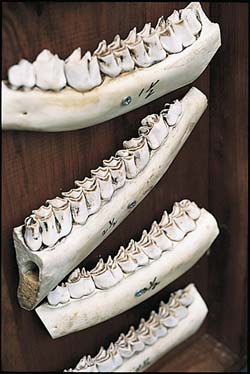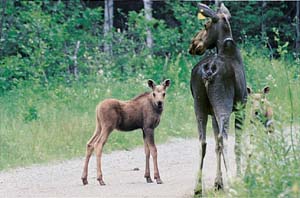 |
 |
| current issue |  |
past issues |  |
send a letter/news |  |
address update |  |
advertise |  |
about us |  |
alumni home |
Features
The Not-So-Elusive Modern MoosePage 4 of 4
Other possible causes of mortality are attacks on young calves by black bears or coyotes, as well as destruction of habitat. The latter has not been a problem for the study population of nearly 100 New Hampshire moose, however. Looking at preliminary data, Pekins notes that the most surprising result has been the high number of deaths (more than half of the total) attributed to winter kill—when an animal dies just prior to spring "green up."
"We've found a pretty high number of the previous year's calves dying in April," he says. "Right now our best guess is that they're dying from malnutrition associated with heavy tick loads." According to the National Moose Foundation, the highest number of ticks ever calculated on one animal exceeded 400,000, found on a moose in Manitoba. Unlike the deer tick, which is actually harmless to deer, the winter moose tick has only one host, and remains attached from fall until spring, sucking as much as half the animal's total volume of blood. New Hampshire moose can also play host to various infestations of lungworm, brainworm and tapeworm. If there is such a thing as reincarnation, Bontaites notes, "you don't want to come back as a moose."
 Long in the tooth: A moose's age can be gauged by the condition of its teeth. |
 A female moose wearing UNH eartags and a radio-transmitter collar keeps watch over her young calf. |
When and if the study confirms the association between tick load and calf mortality, Fish and Game may start trying to predict tick infestations based on weather information. "If we have a warm dry fall followed by a short winter," says Bontaites, "we may want to cut back on the number of hunting permits."
On the other hand, too many moose—each consuming up to 60 pounds of tree branches a day—could harm the environment by overbrowsing. In fact it was the sight of the deer-damaged forest in national parks where hunting is prohibited that inspired Chris Habeck to leave his job as a sound engineer and go back to school in wildlife management. When deer or moose multiply unchecked, they can decimate young plants in the understory, giving the forest an eerie, parklike appearance and interfering with the natural regeneration of trees.
 A BOW HUNTER'S DREAM: Before they were married, Sandy Trybulski (above) spent many dates hunting woodchucks with Bill Trybulski. Actually, Bill did the hunting while Sandy sat in the Jeep, reading a book. Then one day Sandy decided to get out of the truck, and she's been hunting ever since. Today, in fact, she is the reigning national triple crown champion of women's 3-D bow hunting. The Trybulskis have been entering New Hampshire's moose-hunt lottery every year since it began in 1988. Last year, they finally won a permit. After several scouting trips and four days of hunting, Trybulski, an employee in the Sullivan County office of UNH Cooperative Extension, found her moose on Mt. Sunapee. Following an old Native American custom, the couple placed a hemlock sprig in the bull's mouth and thanked him for giving his life. They shared the 500 pounds of meat with four friends who helped them carry it down the mountain. The antlers were measured at 52 and a half inches.
A BOW HUNTER'S DREAM: Before they were married, Sandy Trybulski (above) spent many dates hunting woodchucks with Bill Trybulski. Actually, Bill did the hunting while Sandy sat in the Jeep, reading a book. Then one day Sandy decided to get out of the truck, and she's been hunting ever since. Today, in fact, she is the reigning national triple crown champion of women's 3-D bow hunting. The Trybulskis have been entering New Hampshire's moose-hunt lottery every year since it began in 1988. Last year, they finally won a permit. After several scouting trips and four days of hunting, Trybulski, an employee in the Sullivan County office of UNH Cooperative Extension, found her moose on Mt. Sunapee. Following an old Native American custom, the couple placed a hemlock sprig in the bull's mouth and thanked him for giving his life. They shared the 500 pounds of meat with four friends who helped them carry it down the mountain. The antlers were measured at 52 and a half inches.
|
That's when the "mighty tick" could actually come to the rescue, notes Pekins. "The tick may effectively limit population growth by reducing calf survival and, in turn, protect the forest from an overpopulation of moose."
As the moose study winds down this year, Pekins is launching projects on wild turkeys and black bears, two other species that have rebounded across New England. Meanwhile Habeck is off to Wisconsin, where he will use aphid research to study habitat degradation while earning a doctorate. He already has the researcher's ability to hypothesize about complex environmental systems. "As the climate gets warmer," he predicts, "tree species will migrate northward. The foraging patterns of moose will help determine which trees shift their home range over time."
In other words, even as we carefully plot ways to manage the moose's world, the moose may be subtly shaping ours.~
Page: < Prev 1 2 3 4Easy to print version
blog comments powered by Disqus

